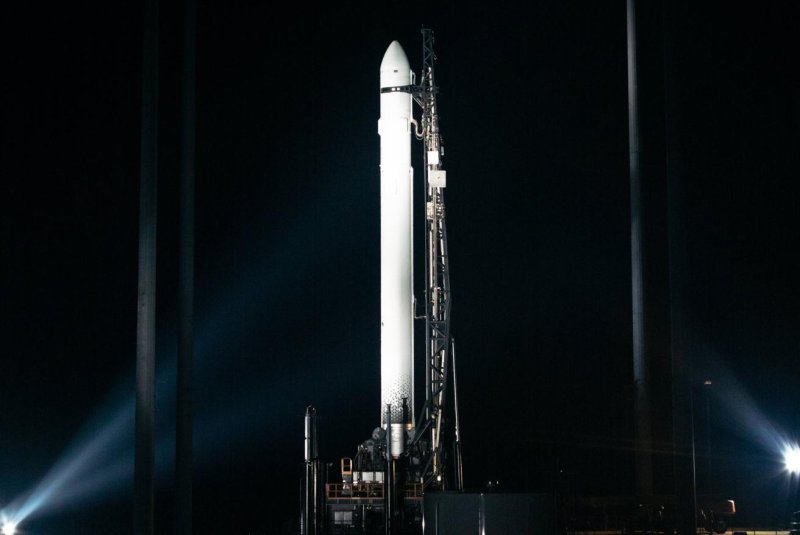1 of 4 | The rocket Terran 1 awaits liftoff Wednesday night at Florida's Cape Canaveral Space Force Station. Relativity Space successfully launched the 3D-printed rocket at 11:25 p.m. EDT, but it failed to reach orbit. Photo courtesy of Relativity Space
March 22 (UPI) -- Relativity Space launched the world's first 3D-printed rocket Wednesday night following two previous launch aborts this month. Despite the successful launch, the rocket failed to reach orbit after suffering an engine problem.
The rocket Terran 1 blasted off from Launch Complex-16 at Florida's Cape Canaveral Space Force Station at 11:25 p.m. EDT, but experienced a problem several minutes into the flight with its upper stage, which is designed to ignite separate engines to boost it into orbit.
"Today's launch proved Relativity's 3D-printed rocket technologies that will enable our next vehicle, Terran R," Relativity Space tweeted shortly after the test flight.
"We successfully made it through Max-Q, the highest stress state on our printed structures. This is the biggest proof point for our novel additive manufacturing approach," the company added.
"Today is a huge win, with many historic firsts. We also progressed through Main Engine Cutoff and Stage Separation. We will assess flight data and provide public updates over the coming days."
The tweet ended with the hashtag #GoodLuckHadFun, which was the company's nickname for the test flight.
The two-stage Terran 1 rocket is a 110-foot-tall launcher designed to carry more than a ton of cargo into low Earth orbit. The Terran 1 will target the commercial launch market for small to mid-size satellites, but did not carry any satellites when it launched Wednesday.
"There are a number of firsts here potentially on this rocket," Josh Brost, vice president of revenue operations at Relativity Space, said before the launch. "It has the chance of being the first liquid natural gas/liquid oxygen rocket to make it to orbit."
"It has, by far, the highest 3D-printed content of any rocket in history. We're sitting at about 85% by mass, where I don't think any other rocket has gone past maybe 4%," Brost added.
Wednesday's launch was the rocket's third attempt for the aerospace startup, which is headquartered in Long Beach, Calif. Launches were called off March 8 and on March 11 after a series of aborts were triggered during the countdowns, just seconds before liftoff.
Relativity Space said the first abort was related to a "corner case in the state separation automation" that "properly aborted" within a second of liftoff.
After pushing the launch to the edge of the three-hour launch window, an automated abort triggered around T-45 seconds because fuel pressure for the rocket's second stage was low.
"The team went HARD today and we intend to do so during our next attempt," Relativity Space said March 11.
The first scheduled liftoff was postponed three days earlier after the launch system automatically aborted during countdown twice because of fuel temperature issues, pushing the launch beyond its liftoff window.
Work to prepare for Wednesday's successful Terran 1 launch involved a number of "software redline tweaks" to resolve preset limits that were tripped and automatically aborted the first two liftoffs, according to Tim Ellis, co-founder and chief executive officer of Relativity Space.
"No new company has ever had their liquid rocket make it to space on their first attempt," Brost said before the company attempted its third launch.
"So if everything goes incredibly well, and we achieve orbit on our first launch Wednesday, that would be a remarkable milestone for us, which we would be, over the moon excited about."















